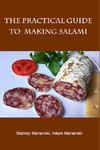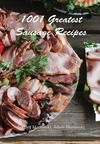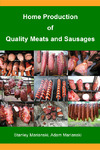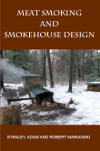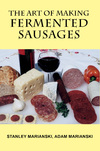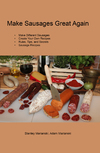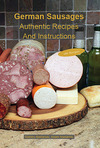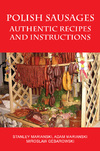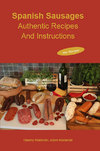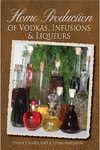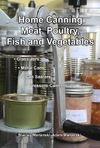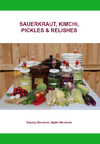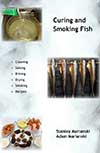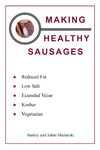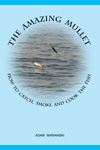Meats and Sausages
Nitrates
In the past, when we used salt with a higher nitrate content, we discovered that the meat had a different taste and color. Rock salts were mined in different areas of the world and exhibited different properties that depended mainly on impurities contained within. Take, for example, Himalayan salt that is sold on the Internet for cooking - it is pink. Seasalt is loaded with impurities, including a small percentage of nitrate. Potassium Nitrate was the main ingredient for making gunpowder; its commercial name was saltpeter, still used today. Potassium Nitrate (KNO3-Bengal saltpeter) or sodium Nitrate (NaNO3- Chile saltpeter) were often added to water, causing the temperature to drop, and that method was used to cool wine in the XVI century. Nitrates and nitrites are powerful poisons, so the Food and Drug Administration established limits for their use. So why do we use them? The simple answer is that after testing and experiments, our modern science has not come up with a better solution to cure meats and prevent food poisoning.
In the XIX century, a German researcher Justinus Kemer linked food poisoning to contaminated sausages. It took another 80 years to discover botulinum bacteria by Emile Pierre van Ermengem, Professor of bacteriology at the University of Ghent, in 1895. The first scientific papers that explained the behavior of Nitrates were published only in the XX century, so why had we been using Nitrates so much in the past? Certainly, not to prevent botulism we had never even heard of before.
We had been and still are using Nitrates because:
- Nitrates can preserve meat’s natural color. When roasted, the same piece of pig's rear leg will have a light brown color, known as a roasted leg of pork. Add some nitrates to it, cook it, and it becomes ham with its characteristic pink color.
- Nitrates impart a characteristic cured flavor to the meat.
- Nitrates prevent the transformation of botulinum spores into toxins, thus eliminating the possibility of food poisoning.
- Nitrates delay the development of rancidity (off flavors) in fat.
What’s Better, Nitrate or Nitrite?
Nitrates and nitrites are permitted to be used in curing meat and poultry, with the exception of bacon, where Nitrate use is prohibited. Sodium nitrite is commonly used in the USA (Cure #1) and everywhere else in the world. To add to the confusion, our commonly available cures contain both nitrite and Nitrate.
Many commercial meat plants prepare their cures using nitrite and Nitrate. All original European sausage recipes included Nitrate, which now should be replaced with nitrite. So what is the big difference? Almost no difference at all. The final result is the same whether we use Nitrate or nitrite. The difference between Nitrate and nitrite is as big as the difference between wheat flour and bread baked from it. The Nitrate is the Mother that gives birth to the Baby (nitrite). Pure sodium nitrite is a more powerful poison than Nitrate as only about ⅓ of a teaspoon is needed to put your life in danger, whereas, in the case of Nitrate, you may need 1 teaspoon or more. So, all these explanations that nitrite is safer for you make absolutely no sense at all. Replacing Nitrate with nitrite eliminates questions like: do I have enough nitrite to cure the meat? Simply put, it is more predictable and easier to control the dosage. Another good reason for using nitrite is that it is effective at low temperatures 36-40° F, (2-4° C), whereas Nitrate likes temperatures a bit higher 46-50° F, (8-10° C). By curing meats at lower temperatures, we slow down the growth of bacteria, extending the product's shelf life.
When Nitrates were used alone, salt penetration was usually ahead of color development. As a result, large cured pieces of meat were too salty when fully colored and had to be soaked in water. This problem has been eliminated when using nitrite. Nitrite works much faster and the color is fixed well before salt fully penetrates the meat. Estimating the required amount of Nitrate is harder as it is dependent on:
- Temperature (with higher temperature, more nitrite is released from Nitrate).
- Amount of color and flavor forming bacteria in meat that is needed for Nitrate to release nitrite, and we do not have control here. The more of these naturally occurring in meat bacteria present, the more nitrite is produced. Adding a small amount of sugar is beneficial as it provides food for bacteria to grow faster. That is why all recipes that contained nitrate also included sugar.
Nitrates And The Law
Maximum in-going nitrite and Nitrate Limits in PPM (parts per million) for Meat and Poultry Products as required by the U.S. Food Safety and Inspection Service
| Curing Agent | Curing Method | |||
|---|---|---|---|---|
| Immersion Cured | Massaged or Pumped | Comminuted (Sausages) | Dry Cured | |
| Sodium Nitrite | 200 | 200 | 156 | 625 |
| Potassium Nitrite | 200 | 200 | 156 | 625 |
| Sodium Nitrate | 700 | 700 | 1718 | 2187 |
| Potassium Nitrate | 700 | 700 | 1718 | 2187 |
The European Directive 95/2/CE (1995) allows 150 ppm of nitrite (if alone) or 300 ppm when combined (nitrite plus Nitrate), and the residual values should be less than 50 ppm (if alone) or 250 ppm (if combined). There are more stringent limits for curing agents in bacon to reduce the formation of nitrosamines. For this reason, Nitrate is no longer permitted in any bacon (pumped and/or massaged, dry cured, or immersion cured). As a matter of policy, the Agency requires a minimum of 120 ppm of ingoing nitrite in all cured “Keep Refrigerated” products, unless the establishment can demonstrate that safety is assured by some other preservation process, such as thermal processing, pH or moisture control. This 120 ppm policy for in-going nitrite is based on safety data reviewed when the bacon standard was developed. Take note that nitrosamines can only be formed when products are heated above 266° F (130° C). This can only happen when cured bacon is fried or cured sausage is grilled. The majority of cured and smoked meats never reach such high temperatures.
There is no regulatory minimum in-going nitrite level for cured products that have been processed to ensure their shelf stability (such as having undergone a complete thermal process, or having been subjected to adequate pH controls, and/or moisture controls in combination with appropriate packaging). However, 40-50 ppm nitrite is useful in that it has some preservative effect. This amount has also been shown to be sufficient for color-fixing purposes and to achieve the expected cured meat or poultry appearance. Some thermally processed shelf-stable (canned) products have a minimum in-going nitrite level that must be monitored because it is specified as a critical factor in the product’s process schedule. By the time meats are consumed, they contain less then 50 parts per million of nitrite. It is said that commercially prepared meats in the USA contain about 10 ppm of nitrite when bought in a supermarket. Nitrite and Nitrate are not permitted in baby, junior or toddler foods.
Nitrate Safety Concerns
There has been much concern over the consumption of Nitrates by the general public. Studies have shown that when nitrites combine with by-products of protein (amines in the stomach), that leads to the formation of nitrosamines which are carcinogenic (cancer causing) in laboratory animals. There was also a link that when Nitrates were used to cure bacon and the latter one was fried until crispy, it helped to create nitrosamines. To accomplish that, the required temperatures had to be in the 600° F (315° C) range. Most meats are smoked and cooked below 200° F (93° C), so they are unaffected. Those findings started a lot of unnecessary panic in the 1970’s about the harmful effects of nitrates on our health. Millions of dollars were spent, a lot of research was done, and many researchers had spent long sleepless nights seeking fame and glory, but no evidence was found that when Nitrates are used within the established limits, they pose any danger to our health.
A review of all scientific literature on nitrite by the National Research Council of the National Academy of Sciences indicates that nitrite does not directly harm us in any way. All this talk about the danger of nitrite in our meat pales in comparison with the amounts of Nitrates that are found in vegetables that we consume every day. The Nitrates get to them from the fertilizers used in agriculture. Don’t blame sausages for the Nitrates you consume; blame the farmer. When carcinogenic nitrosamines are concerned, a simple advice is given: eating vegetables regularly is more dangerous to one's health than a sausage.
Nitrates in Vegetables
The following information about Nitrates in vegetables was published by MAFF, Department of Health and the Scottish Executive before April 1st 2000 when the Food Standards Agency was established. Number 158, September 1998. MAFF UK - NITRATE IN VEGETABLES: Vegetables contain higher concentrations of Nitrate than other foods and make a major contribution to dietary intake. A survey of vegetables for sale in supermarkets was carried out in 1997 and 1998 to provide up-to-date information on Nitrate concentrations, to assess the health implications for UK consumers and also to inform negotiations on a review of the European Commission Regulation (EC) No. 194/97 (which sets maximum levels for Nitrate in lettuce and spinach).
A study on the effects of cooking on Nitrate concentrations in vegetables was also carried out to provide further refinements for estimating dietary exposure. The vegetables were tested and the mean Nitrate concentrations found were as listed in the table on the right. For comparison the permissible amount of Nitrate in comminuted meat products (sausages) is 1718 mg/kg. If one ate 1/4 lb smoked sausage, the ingoing Nitrate would be 430 ppm. That would probably account for less Nitrates than a dinner served with potatoes and spinach.
In the 1920’s, the government allowed the addition of 10 lbs. of Nitrate to 100 gallons of water (7 lbs. allowed today). The problem was that only about one quarter of the meat plants adhered to those limits and many plants added much more, even between 70 and 90 pounds. There was no control and as a result the customer was eating a lot of Nitrates.
| Vegatable | Nitrate in mg/kg |
| spinach | 1631 |
| beetroot | 1211 |
| lettuces | 1051 |
| cabbages | 338 |
| potatoes | 155 |
| swedes | 118 |
| carrots | 97 |
| califlowers | 86 |
| brussel sprouts | 59 |
| onions | 48 |
| tomatoes | 17 |
Cooking by boiling reduced Nitrate concentrations in most vegetables tested by up to 75 percent. Frying and baking did not affect Nitrate concentrations in potatoes but frying caused increases in levels in onions. Dietary intakes of mean and upper range (97.5 percentile) consumers of these vegetables are 104 mg/day and 151 mg/day, respectively. These are below the Acceptable Daily Intake (ADI) for nitrate of 219 mg/day for a 60 kg adult set by the European Commission’s Scientific Committee for Food (SCF). There are therefore no health concerns for consumers. Ten years later in 2008 another British study concluded: “Our research suggests that drinking beetroot juice, or consuming other Nitrate-rich vegetables, might be a simple way to maintain a healthy cardiovascular system, and might also be an additional approach that one could take in the modern-day battle against rising blood pressure,” says Amrita Ahluwalia, PhD, one of the study’s researchers. Ahluwalia is a professor at the William Harvey Research Institute at Barts and The London School of Medicine.
How Much Nitrite is Dangerous
According to the report prepared in 1972 for the U.S. Food and Drug Administration (FDA) by Battele-Columbus Laboratories and Department of Commerce, Springfield, VA 22151 – the fatal dose of potassium Nitrate for humans is in the range of 30 to 35 grams (about two tablespoons) consumed as a single dose; the fatal dose of sodium nitrite is in the range of 22 to 23 milligrams per kilogram of body weight. A 156 lbs adult (71 kg) would have to consume 14.3 pounds (6.5 kg) of cured meat containing 200 ppm of sodium nitrite at one time. Since nitrite is rapidly converted to nitric oxide during the curing process, the 14.3 lbs amount will have to be doubled or even tripled. The equivalent amount of pure sodium nitrite consumed will be 1.3 g. One gram (1 ppm) of pure sodium nitrite is generally accepted as a life-threatening dose.
As nitrite is mixed with large amounts of salt, it would be impossible to swallow it, at least from a culinary point of view. Besides, our cures are pink, and it would be hard to mistake them for common salt.
The following information comes from the book “Meat Through the Microscope” written by C.Robert Moulton, Ph.D. and W.Lee Lewis, Ph.D. and published by Institute of Meat Packing, The University of Chicago:
Effect of Operations on Composition of Hams
| Stage | Salt % | Sugar % | Nitrate % | Nitrite p.p.m. | Water % |
|---|---|---|---|---|---|
| Out of cure | 4.93 | 0.79 | 0.057 | 138 | 65 |
| Soaked | 4.60 | 0.72 | 0.048 | 115 | 67 |
| Smoked | 5.15 | 0.76 | 0.060 | 80 | 65 |
| Baked | 4.30 | 0.63 | 0.050 | 2 | 56 |
To emphasize the importance of these results, and especially of the very great destruction of nitrite by baking, one should remember in contrast that sweet-pickle solutions contain from 500 to 1000 parts of nitrite per million and that the surface of hams removed from such pickles, especially at the ragged edges of the butt, will most certainly contain over 200 p.p.m. However, after soaking and smoking, the average nitrite content is well within the prescribed limits. In the survey summarized above only two out of 10 surface sections showed over 200 p.p.m. of nitrite. Despite the figures given in the first part of this paragraph, no subsection of surface meat showed more than 11 p.p.m. after baking.
By the time meats are consumed, they contain less then 50 parts per million of nitrite. It is said that commercially prepared meats in the USA contain about 10 ppm of nitrite when bought in a supermarket.
If we follow USDA recommendations, Nitrates/nitrites are perfectly safe.

